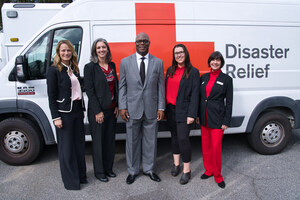WASHINGTON, June 30, 2015 /PRNewswire-USNewswire/ -- A new report released today from the Institute of Medicine calls for a campaign to promote public education and training opportunities to reduce barriers to the provision of bystander CPR and defibrillation.
Annual rates of CPR and AED use by bystanders remain less than three percent in the United States even though evidence indicates that its use significantly improves cardiac arrest survival. The American Red Cross strongly supports the IOM's recommendation to encourage training through employers, local public health departments, schools and community organizations. The Red Cross also encourages businesses to include cardiac arrest in their formal emergency response plans.
More than 1,600 people suffer a cardiac arrest each day in the U.S., with disparate survival rates within the population. Out-of-hospital cardiac arrest survival rates vary from less than 10 percent to more than 60 percent, with minorities and those of lower economic status faring worse.
The Red Cross trains more than two million people annually in First Aid, CPR and AED use. It has supported state legislation to make CPR and AED training a graduation requirement for middle school and high school students, a recommendation put forth in the IOM report, for several years. Currently, only 23 states require CPR education in order to graduate from high school.
"This is an important year for resuscitation science and this report dovetails with critical updates in Emergency Cardiac Care coming in October," said David Markenson, MD, a member of the IOM Committee on the Treatment of Cardiac Arrest. "It's important that we in the resuscitation field pay heed to the new recommendations in the IOM report so that we can marshall the necessary resources to continuously improve survival rates."
Additionally, in response to the IOM report's recommendation, the Red Cross announced that it is convening the National Cardiac Arrest Collaborative to establish common goals to improve cardiac arrest survival rates among organizations operating in the resuscitation field. The Collaborative will also address other IOM strategies, including a call for public education and training opportunities for CPR and defibrillation and the development of national accreditation standards for hospitals and health care systems.
"If we want to improve cardiac arrest outcomes, the resuscitation field must demonstrate leadership and accountability. It must take action to safeguard the quality of life for those who suffer a cardiac arrest," said Markenson.
Added Richard Bradley, MD, chair of the Resuscitation Subcouncil of the American Red Cross Scientific Advisory Council, which guides the Red Cross on the science behind its training programs, "The Red Cross is taking a key first step in gathering those who can make a significant difference in strengthening the entire system of response to cardiac arrest."
The convening of the National Cardiac Arrest Collaborative will be held at the Emergency Cardiac Care Update 2015 conference in San Diego December 7. Organizations that have committed to participate include the American Heart Association, Citizen CPR Foundation, and the National Registry of Emergency Medical Technicians.
Other recommendations in the IOM report that the Red Cross intends to enact are:
- National accreditation standards related to cardiac arrest for hospitals and health care systems. The IOM report calls for the Joint Commission to collaborate with the Red Cross, the American Heart Association (AHA) and other organizations to develop and implement an accreditation standard for health care facilities specific to cardiac arrest care. The Red Cross stands ready to work with the AHA to bring this about and will put it on the agenda at the convening of the National Cardiac Arrest Collaborative.
- The establishment of a national registry to track out-of-hospital cardiac arrests. The Red Cross partners with the Emory University-based CARES program (Cardiac Arrest Registry to Enhance Survival), which currently covers 25 percent of the U.S. population with approximately 200,000 cardiac events logged since its launch in 2004 in collaboration with the Centers for Disease Control and Prevention. The Red Cross supports CARES as part of its mission to train people how to prepare for and respond to emergencies.
- Enhance the capabilities and performance of emergency medical services (EMS) systems. The Red Cross has already incorporated teamwork and high-performance CPR into its new Basic Life Support course for healthcare providers and fully supports the establishment of a standardized definition and training curriculum for high-performance CPR to be used within EMS systems.
The IOM report is a consensus study on the factors affecting resuscitation research and outcomes in the United States. The IOM convened a 19-member committee with a broad range of expertise in 2013; the committee held five meetings and two public workshops throughout its two-year term in order to solicit input from a variety of stakeholders. In addition to input received through public workshops, the committee examined the available scientific literature and commissioned analyses of recent data on out-of-hospital cardiac arrest and in-hospital cardiac arrest.
About the American Red Cross:
The American Red Cross shelters, feeds and provides emotional support to victims of disasters; supplies about 40 percent of the nation's blood; teaches skills that save lives; provides international humanitarian aid; and supports military members and their families. The Red Cross is a not-for-profit organization that depends on volunteers and the generosity of the American public to perform its mission. For more information, please visit redcross.org or visit us on Twitter at @RedCross.
Logo - http://photos.prnewswire.com/prnh/20090108/RedCrossLOGO
SOURCE American Red Cross
Related Links
WANT YOUR COMPANY'S NEWS FEATURED ON PRNEWSWIRE.COM?
Newsrooms &
Influencers
Digital Media
Outlets
Journalists
Opted In






Share this article